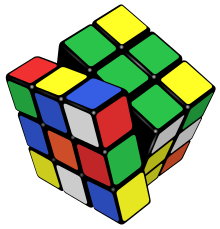
Back Grupo del cubo de Rubik Spanish Groupe du Rubik's Cube French Gruppo del cubo di Rubik Italian റൂബിക്സ് ക്യൂബ് ഗ്രൂപ്പ് Malayalam Группа кубика Рубика Russian Група кубика Рубіка Ukrainian 魔術方塊群 Chinese

The Rubik's Cube group represents the structure of the Rubik's Cube mechanical puzzle. Each element of the set corresponds to a cube move, which is the effect of any sequence of rotations of the cube's faces. With this representation, not only can any cube move be represented, but any position of the cube as well, by detailing the cube moves required to rotate the solved cube into that position. Indeed with the solved position as a starting point, there is a one-to-one correspondence between each of the legal positions of the Rubik's Cube and the elements of .[1][2] The group operation is the composition of cube moves, corresponding to the result of performing one cube move after another.
The Rubik's Cube is constructed by labeling each of the 48 non-center facets with the integers 1 to 48. Each configuration of the cube can be represented as a permutation of the labels 1 to 48, depending on the position of each facet. Using this representation, the solved cube is the identity permutation which leaves the cube unchanged, while the twelve cube moves that rotate a layer of the cube 90 degrees are represented by their respective permutations. The Rubik's Cube group is the subgroup of the symmetric group generated by the six permutations corresponding to the six clockwise cube moves. With this construction, any configuration of the cube reachable through a sequence of cube moves is within the group. Its operation refers to the composition of two permutations; within the cube, this refers to combining two sequences of cube moves together, doing one after the other. The Rubik's Cube group is non-abelian as composition of cube moves is not commutative; doing two sequences of cube moves in a different order can result in a different configuration.
- ^ Joyner, David (2002). Adventures in group theory: Rubik's Cube, Merlin's machine, and Other Mathematical Toys. Johns Hopkins University Press. ISBN 0-8018-6947-1.
- ^ Davis, Tom (2006). "Group Theory via Rubik's Cube" (PDF).



